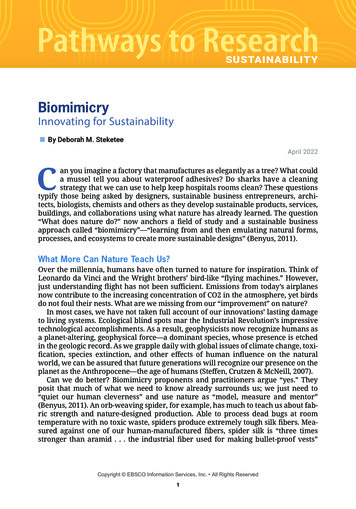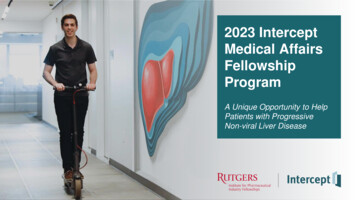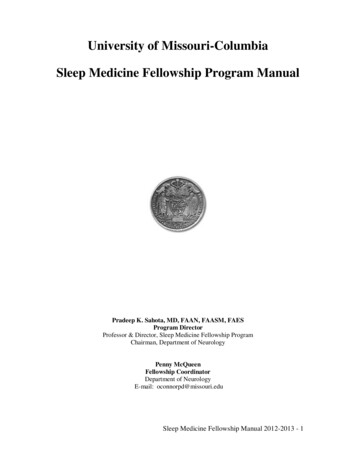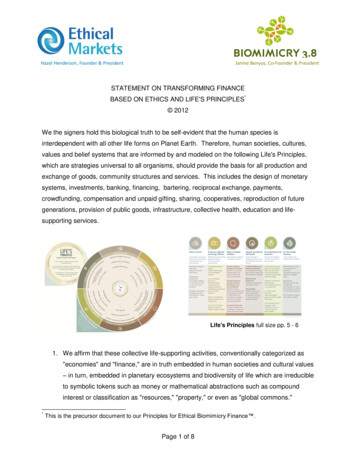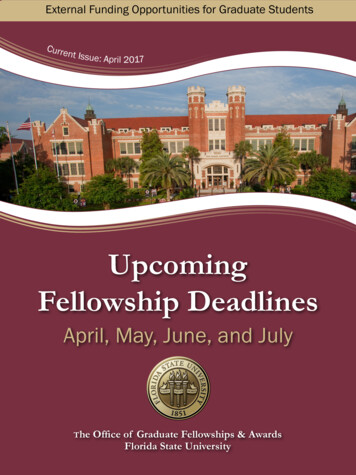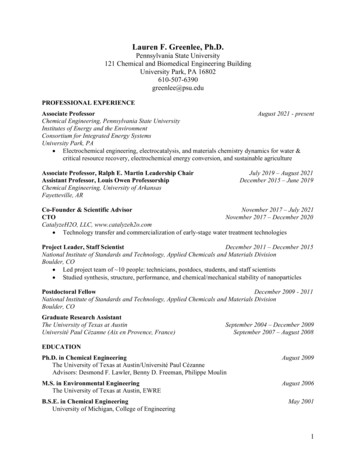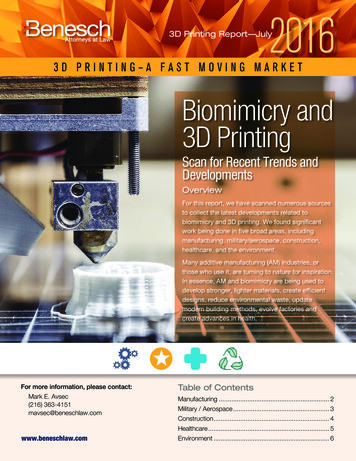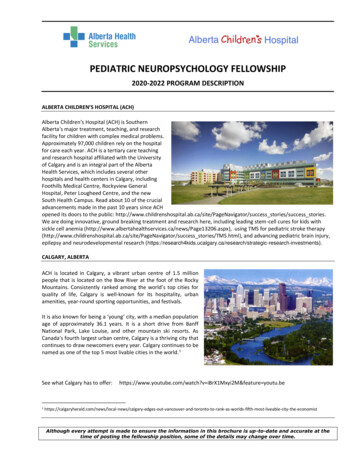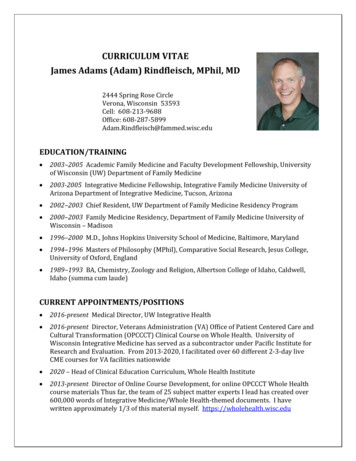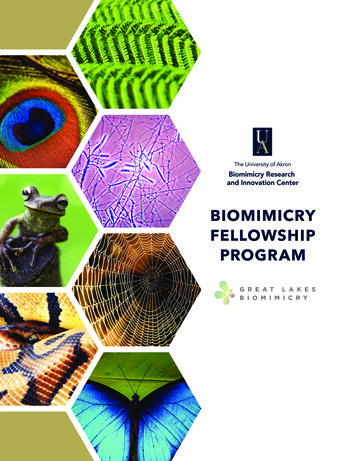
Transcription
BIOMIMICRYFELLOWSHIPPROGRAM
ABOUTThe Biomimicry Fellowship Program was launched in 2012 by The University of Akron’s (UA) BiomimicryResearch and Innovation Center (BRIC), in collaboration with Great Lakes Biomimicry. The mission of theprogram is to provide interdisciplinary training in biology, design, engineering and business to nextgeneration innovators. The vision is for biomimicry to become a driver for economic development inNortheast Ohio and beyond.Biomimicry Fellows are UA doctoral students who are supported through industrial assistantships withorganizational sponsors, rather than through teaching assistantships or research grants. Over the courseof a typical five-year doctoral program, Biomimicry Fellows dedicate up to 20 hours per week to advancingbiomimicry initiatives within their sponsoring organizations. Intellectual property originated, conceived ormade as part of the Biomimicry Fellow’s activities with the sponsor is owned by the sponsor.To be eligible for a Biomimicry Fellowship, an individual must be admitted with intent to enroll in adoctoral program at UA. Oftentimes, a prospective Biomimicry Fellow will apply for admission to anacademic program, and for a Biomimicry Fellowship, in parallel. Students in the first year of a doctoralprogram at UA may also be considered for Biomimicry Fellowships. To date, all Biomimicry Fellows haveenrolled in UA’s integrated bioscience and polymer science doctoral programs, but other tracks arepossible.SPONSORSHIPThe organizational sponsor develops a recruiting profile with the assistance of BRIC’s director of externalrelations. Applications of prospective Biomimicry Fellows who meet the relevant program’s admissionrequirements are reviewed in consultation with the sponsor. Interviews are arranged with short-listedcandidates. When the position is filled, an advisory committee composed of faculty mentors and, often, arepresentative of the sponsoring organization is constructed to guide the student through research plandevelopment and execution.A Year 1 onboarding initiative, the Biomimicry Jump Start Program, managed by Great LakesBiomimicry with support from BRIC, accelerates fellow integration at the sponsoring organization viaseminars, discovery meetings and a workshop. eminars: Organization-wide socialization of biomimicry via a lunch hour presentation; deeperSeducation for executives and personnel working directly with the fellow iscovery meetings: Dialogue about historically successful approaches to utilizing a fellow; high-levelDdiscussion of sponsor’s R&D goals to help identify potential entry points for biomimicry; regularcheck-ins to assess the fellow’s progress and troubleshoot issues orkshop: Hands-on experience with biomimicry tools that support various stages of the processW(e.g., cataloging functions, identifying biological models, extracting design principles)Fellows and sponsors become members of Great Lakes Biomimicry’s Corporate Innovation Council.Membership provides the sponsor with valuable knowledge and connections, special workshops andshared resources. During biannual meetings, sponsors share the ways biomimicry brings value to theirorganizations, e.g., generating intellectual property, embedding non-traditional thinking into teams,adding talent, creating sustainable value and providing access to biomimicry tools. Members learn fromone another’s challenges and successes, tap into a robust biomimicry ecosystem in Northeast Ohio, andhear from cutting-edge researchers and practitioners in the field of biomimicry. Through the CorporateInnovation Council, Great Lakes Biomimicry supports each company’s unique journey as a leader in thisnew field.“ If you’re not incorporating the most brilliant ideas from the naturalworld into what you sell, you’re leaving money on the table.”- Fortune magazine (March 2017)
COSTThe current cost to sponsor a fellow is 191,071 for the typical five years.Below is an annual cost breakdown.Before student passescandidacy exams andproposal defenseAfter student passescandidacy exams andproposal defense*STUDENT STIPEND** 21,500 23,500FRINGE BENEFITS*** 1,183 1,293ADMINISTRATIVE FEE**** 5,898 6,446BIOMIMICRY JUMP START PROGRAM (YEAR 1) 12,850N/ACORPORATE INNOVATION COUNCIL MEMBERSHIP 6,000 6,000APPROXIMATE ANNUAL TOTAL 47,431 Year 1 and 34,581 thereafter 37,239*When the student passes the candidacy exams and proposal defense, the student stipend increases by 2,000 for subsequent contractyears. Typically, a student will achieve these milestones in Year 3, resulting in an increased rate for Years 4 and 5.**The stipend must meet the minimum set by the college in which the student will pursue a doctoral degree. The figures in the table aboveassume enrollment in the Integrated Bioscience Ph.D. Program (Buchtel College of Arts and Sciences), historically the most popular trackfor Biomimicry Fellows; but fellowships have been awarded to students enrolling in other Ph.D. programs, such as polymer science(College of Polymer Science and Polymer Engineering, the minimum stipend for which is 25,000).***The fringe benefits rate for Graduate Assistants is 5.5% of the student stipend and covers the University’s Medicare contributions,retirement contributions and workers’ compensation policy.****The administrative fee is 26% of the sum of the student stipend and fringe benefits, and covers University overhead associated withadministering sponsored projects (Human Resources, Office of Research Administration, Payroll, Purchasing, Provost, Student Services, etc.).The University of Akron bills quarterly (mid-September, -December, -March, and -June) for thestudent stipend fringe benefits administrative fee. Great Lakes Biomimicry bills annuallyfor Corporate Innovation Council membership and includes the cost of the Biomimicry JumpStart Program in the Year 1 bill.CURRENT FELLOWRESEARCH TOPICSREBECCA EAGLE-MALONE Cleveland Metroparks ZooRebecca, from Ohio, is investigating the connection between biomimicry education and conservationactions. She also studies vascular plant tolerances to determine viability for growth on Mars.SARAH HAN The Goodyear Tire & Rubber Co.Sarah, from California, is investigating arthropod tissue and structure’s influence on biomechanics,especially rapid motions, assessed using high-speed videography.STEPHEN HOWE Bendix Commercial Vehicle Systems, LLCStephen, from California, is investigating fish maneuverability. Results could be useful in simplifying thecontrol of autonomous and remotely operated underwater vehicles.BANAFSHEH KHAKIPOOR Teaching Institute for Excellence in STEMBanafsheh, from Iran, is applying artificial neural networks for prediction of harmful algal blooms (HABs) anddead zones in Lake Erie. She is also part of a team developing a DIY Spectrometer and associatedsmartphone app allowing amateur scientists to measure and map phosphorus and nitrogen levels in LakeErie. Banafsheh is also integrating biomimicry in K-12 curricula, helping students rediscover nature whilelearning about math, physics and programming.DANIEL MAKSUTA Kimberly-Clark Corp.Daniel, from Ohio, is using biomimicry for diaper innovation and investigating how to improve productswith solutions that deviate from the typical cost-benefit curve.SARAH MCINERNEY The J.M. Smucker Co.Sarah, from Ireland, is investigating the hurdles industry faces during adoption and implementation ofbiomimicry. She is exploring biomimicry’s effect on workforce alignment with corporate sustainabilityinitiatives, applying biomimicry thinking to sustainable packaging design and developing models forindustry collaboration with museums/zoos to enable access to biological expertise.ARIANA RUPP Nottingham SpirkAriana, from Portugal, is investigating thermal systems inspired by leaf morphology andevapotranspiration to inform design of multi-scale heat transfer devices for industrial, architectural ormakerspace application.
CURRENT FELLOWRESEARCH TOPICS(CONTINUED)DEREK SCHWARZ PolyOne Corp.Derek, from Ohio, is applying his polymer and biochemical expertise to a variety of PolyOne interestareas, including innovative material development.KELLY SIMAN Cleveland Water AllianceKelly, from Ohio, is working to improve coastal ecosystem resiliency and land use impacts on Lake Erieand other nearshore waterways while boosting water innovation in the region. Her research focuses onbiomimetic applications that support long-term system resilience, moving away from “random acts ofrestoration” to a holistic, data-driven approach to management.LAMALANI SIVERTS Avon Lake Regional WaterLamalani, from California, is tracking the biogeochemistry between phytoplankton and zebra/quaggamussels in communities that experience harmful algal blooms (HABs) to zero in on HAB-predictive signalsin this complex food web which could be detected with inexpensive sensors. She is also bringing waterquality awareness to the education system through STEM projects for middle and high school students.ELENA STACHEW BiohabitatsElena, from Michigan, is using biomimicry to inform ecological design of coastal stabilization, restorationand urban stormwater management practices through prototyping, design and process integration.BERND STEKLIS Tremco Inc.Bernd, from Arizona, is investigating various forms of adhesion for practical use in industry and toimprove efficiency and sustainability in factory settings.ADRIAN TWEEN Eaton Corp.Adrian, from Mexico, is studying natural materials to gather insights that could inspire advancedstructures (e.g., acoustic, adaptable, high strength, lightweight) or materials (e.g., composite, smart).COLLEEN UNSWORTH NASA Glenn Research CenterColleen, from Michigan, is investigating the biomechanics of snake and myriapod locomotion to gatherinsights for design of mobility assistance technologies. She is also exploring the potential for biomimicry tocontribute to inclusive design practices.MICHAEL WILSON The Lubrizol Corp.Michael, from Tennessee, is investigating the role of functional groups in caddisfly larvae underwateradhesion.HOPE ZIMMERMAN STERIS EndoscopyHope, from Ohio, is exploring different biological models from a mechanical perspective to extractinsights relevant to design of medical technologies.PAST FELLOWRESEARCH TOPICSEMILY KENNEDY Class of 2017, GOJO Industries, Inc.Emily, from Massachusetts, applied biomimicry to R&D of energy-efficient soap dispensers, protectivetopical treatments, versatile dispenser brackets and infection control products/processes. Herdissertation made a case for biomimicry in business, providing empirical rationale for reimagining R&D.BOR-KAI “BILL” HSIUNG Class of 2017, The Sherwin-Williams Co.Bill, from Taiwan, studied structural color in spiders. Study of non-iridescent blue tarantulas informeddesign of electronic displays and non-toxic, non-fading colorants. Super-iridescent rainbow peacockspiders inspired a method for separating light into its composite colors with unprecedented efficiency,which may further advance miniaturization of optical instruments.DAPHNE FECHEYR-LIPPENS Class of 2017, Parker Hannifin Corp.Daphne, from Belgium, studied UV-reflective properties of calcium carbonate-based biomaterials, likeavian eggshells, to provide insights for developing industrial materials that don’t degrade in sunlight,and building envelopes that reflect incident light, keeping occupants cool and reducing air conditioningexpenses.SEBASTIAN ENGELHARDT Class of 2019, Ross Environmental Services, Inc.Sebastian, from Germany, investigated wastewater desalination and purification inspired by biologicalprocesses, such as active trans-membrane water transport by aquaporin protein channels.
BRIC FACULTYBRIC has an extended network of 40 faculty. These faculty members have appointments across campus in the BuchtelCollege of Arts and Sciences (BCAS), College of Business Administration (CBA), The LeBron James Family Foundation Collegeof Education (LJFFCOE), College of Engineering (COE), College of Polymer Science and Polymer Engineering (CPSPE), Schoolof Law (Law), and Wayne College (WC).NAME, BRIC ROLECOLLEGEDEPARTMENTRESEARCH INTERESTSDr. Steven Ash, AssociateCBAManagementhuman resources; organizational behaviorDr. Henry Astley, CoreBCAS; CPSPEBiology; Polymer Sciencebiomechanics of animal locomotion; testing motion and control theories withcustom-built robotsDr. Hazel Barton, AssociateBCASBiologymicrobial interactions and adaptations to nutrient limitation, as experienced byecosystems in deep subsurface cave environmentsDr. Carolyn Behrman, AssociateBCASAnthropologyurbanization processes as they relate to gender, health, power, and povertyDr. Todd A. Blackledge, CoreBCASBiologyhow biological materials facilitate organismal function during the diversification ofbehaviors; spider silk, from molecular structure to evolutionary ecologyDr. Amanda Booher, AssociateBCASEnglishmedical and scientific rhetoric; medical humanities and bioethics; theories of bodies,genders, and (dis)abilities; cyborgs, somatechnics, and post-humanismKate Budd, AssociateBCASArttiny carved wax and bronze sculptures that reference organic forms andancient artifactsDr. Alper Buldum, AssociateCOEMechanical Engineeringcomputational materials science; mechanical, electronic, and transport properties ofnanomaterials; nanotechnology; nanotribology; modeling of advanced materials forenergy storage and conversionDr. Ali Dhinojwala, CoreCPSPEPolymer Scienceunderstanding the physical properties of molecules at surfaces and interfaces;adhesion, friction, wetting; structural colorDr. Zhong-Hui Duan, AssociateBCASComputer Sciencefast algorithms and scientific computation; bioinformatics; computational biologyDr. R. Joel Duff, AssociateBCASBiologyusing molecular genetics tools to investigate organismal and genetic biodiversityDr. Stephen Duirk, AssociateCOECivil Engineeringtotal water infrastructure sustainabilityDr. James Eagan, AssociateCPSPEPolymer Sciencesynthesis of new polymeric materials for sustainable applicationsDr. Joelle D. Elicker, AssociateBCASPsychologylearning; feedback; organizational justiceDr. Patrick H. Gaughan,AssociateLawLawinnovation; entrepreneurshipDr. Petra Gruber, CoreBCASArt; Biologyspatial and functional aspects of biological structures for biomimetic innovation inarchitecture and the built environmentDr. Angela Hartsock, AssociateWCBiologybacterial ecology of energy systems with a focus on waters associated with natural gasdrilling; genetics of denitrifying physiology in bacteriaDr. Gary Holliday, AssociateLJFFCOECurricular &Instructional Studiesmiddle level and AYA scienceDr. John Huss, AssociateBCASPhilosophyphilosophy of science, philosophy of biology, ethics, and philosophy of popular culture— especially philosophical implications of metagenomics/microbiome research, andattempts to reconstruct the geologic and evolutionary pastDr. Li Jia, AssociateCPSPEPolymer Sciencetransition metal-catalyzed polymerizations and carbonylations; supramolecularelastomers and micelles; synthesis of polymeric electronic and optoelectronicmaterials; soft lithography via nanoparticle self-assemblyDr. Abraham Joy, AssociateCPSPEPolymer Sciencesynthesis and applications of peptidomimetic biomaterials (polyesters, polyurethanes,poly[ester urethane]s); development of stimuli (light, non-covalent interactions,mechanical) responsive polymersDr. Hunter King, CoreCPSPE; BCASPolymer Science; Biologymechanical mechanisms organisms use to manipulate and couple with theirenvironmentsMatthew Kolodziej, CoreBCASArtpaintings exploring the transitory quality of space and perception; intersectionsbetween art and scienceDr. Lingyun Liu, AssociateCOEChemical, Biomolecular, &Corrosion Engineeringanti-biofouling materials; biomaterials and tissue engineering; materials science
NAME, BRIC ROLECOLLEGEDEPARTMENTRESEARCH INTERESTDr. Richard Londraville,AssociateBCASBiologymolecular and evolutionary biology of fat in zebrafish, lizards, birds, and whalesDr. Francis Loth, AssociateCOEMechanical Engineering;Biomedical Engineeringfluid dynamics of biological flows — especially their importance in the development,progression, and diagnosis of diseaseDr. Christopher M. Miller, CoreCOECivil Engineeringdrinking water plant operations-optimization using machine learning, water qualitymodeling, and collective intelligenceDr. Randy Mitchell, AssociateBCASBiologyevolutionary ecology of plant pollinator interactions — especially how plant matingpatterns and success are affected by pollinator behavior and abundance; wetland andrestoration ecologyDr. Chelsea Monty-Bromer,AssociateCOEChemical, Biomolecular, &Corrosion Engineeringmicro-scale sensors using biological mimics for the detection of toxic compounds;biomimicry for non-biological inhibition-based sensors in order to chemically amplifythe response from various toxic compoundsDr. Francisco (Paco) Moore,AssociateBCASBiologyevolutionary consequences of gene-gene interactions; theoretical population genetics;experimental evolution in bacteria; interface between micro and macro evolution;evolution of noveltyDr. Gopal Nadkarni, AssociateCOEMechanical Engineeringmanufacturing and materials; product and design engineering; technology-basedstartupsDr. Peter H. Niewiarowski, CoreBCASBiologyhow the environment affects the physiology and population biology of salamandersand lizards; gecko adhesionDr. Amir Nourhani, CoreCOE; BCASMechanical Engineering;Biologyfluid dynamics and soft matter with a focus on microrobots and autonomousmechanosensors for potential biomedical, environmental, and energy applicationsDr. Nita Sahai, AssociateCPSPEPolymer Sciencehuman and bacterial cell interactions with biomaterials and minerals; interfacialchemistry; bone-tissue engineering; biomineralization; origin and early evolution oflife; relationship between molecular-level, nanoscale, and macroscopic propertiesAnthony Samangy, AssociateBCASArtdesigning user experiences through time-based or interactive narrativeDr. Shiva Sastry, AssociateCOEElectrical & ComputerEngineeringautomation; networked embedded systems; graph algorithms; software systemsarchitectures; modeling; verificationDr. Marnie M. Saunders,AssociateCOEBiomedical Engineeringorthopedic biomechanics; bone biomechanics; bone cell mechanobiology; lab-on-achip and organ-on-a-chip platformsDr. Adam W. Smith, AssociateBCASChemistrymolecular organization and dynamics in biological membranes; membrane receptorclustering and its role in signaling; lipid-protein interaction dynamicsDr. Kwek-Tze (K.T.) Tan,AssociateCOEMechanical Engineeringimpact, damage, and fracture of composite materials; wave propagation in acousticmetamaterials; unique behavior of mechanical metamaterials; bioinspired structuresand materialsDr. Mesfin Tsige, AssociateCPSPEPolymer Sciencecomputational polymer science and soft condensed matter physics; structure anddynamics of molecules at surfaces and interfaces; elastic and failure behavior ofthermosetting polymers; molecular transport through nanostructured materials;interaction of water with surfacesMarkus Vogl, AssociateBCASArtmultiple sensory experiences combining sound, environments, and interactiveinstallationDr. Stephen Weeks, AssociateBCASBiologydelineating the factors favoring the evolution of hermaphroditism from dioecy inanimals; evolution of mating systems in crustaceans; mating behavior of clam shrimp;human impact on invertebrate communities in freshwater environmentsDr. Chrys Wesdemiotis,AssociateBCASChemistryfundamental studies and analytical applications of mass spectrometry and tandemmass spectrometry to macromolecules; synthetic polymers; biopolymersDr. Anne Wiley, AssociateBCASBiologyusing stable isotopes and other tools to study the ecology of modern and ancientanimal populations; population ecology and human-mediated changes in animal dietand distribution with focus on seabirdsDr. Yingcai (Tom) Xiao,AssociateBCASComputer Sciencecomputer graphics and visualization; numerical simulation and applications
SPONSORTESTIMONIALS“ Biomimicry gives Nottingham Spirk a whole new way to approach brainstorming andproduct development while solving design and engineering problems. Nature is so vast thatwe will never run out of possible inspirations. Now, the first question that we ask in ourinnovation process is, ‘How would nature handle this issue?'”- JOHN NOTTINGHAM, Co-President of Nottingham Spirk“ Studying and emulating biological systems as ideation stimulus sparked totally newapproaches to the design challenge. Many of the solutions we came up with would use farless energy than our current technology, which is not surprising because when you thinkabout it, nature is resource-efficient by necessity.”- TOM MARTING, Facilities, EH&S, and Sustainability Director at GOJO Industries, Inc.“ Biomimicry is an innovation method Kimberly-Clark uses for developing new materials toenable business plans and sustainability goals. Discovering and translating nature’sstrategies helps us open our perspective and solution space when looking for a newapproach or benefit to a product, or to tackle a challenge that hasn’t been solved withtraditional methods.”- CLAY BUNYARD, Research Technical Leader at Kimberly-Clark Corp.CONTACTSPETER NIEWIAROWSKI BRIC Principal InvestigatorBiomimicry Research and Innovation CenterThe University of HA BROWN Co-DirectorGreat Lakes glbiomimicry.orgThe University of Akron is an Equal Education and Employment Institution - uakron.edu/eeo 2019 by The University of Akron / AS-1019-34699
administering sponsored projects (Human Resources, Office of Research Administration, Payroll, Purchasing, Provost, Student Services, etc.). The University of Akron bills quarterly (mid-September, -December, -March, and -June) for the student stipend fringe benefits administrative fee. Great Lakes Biomimicry bills annually
